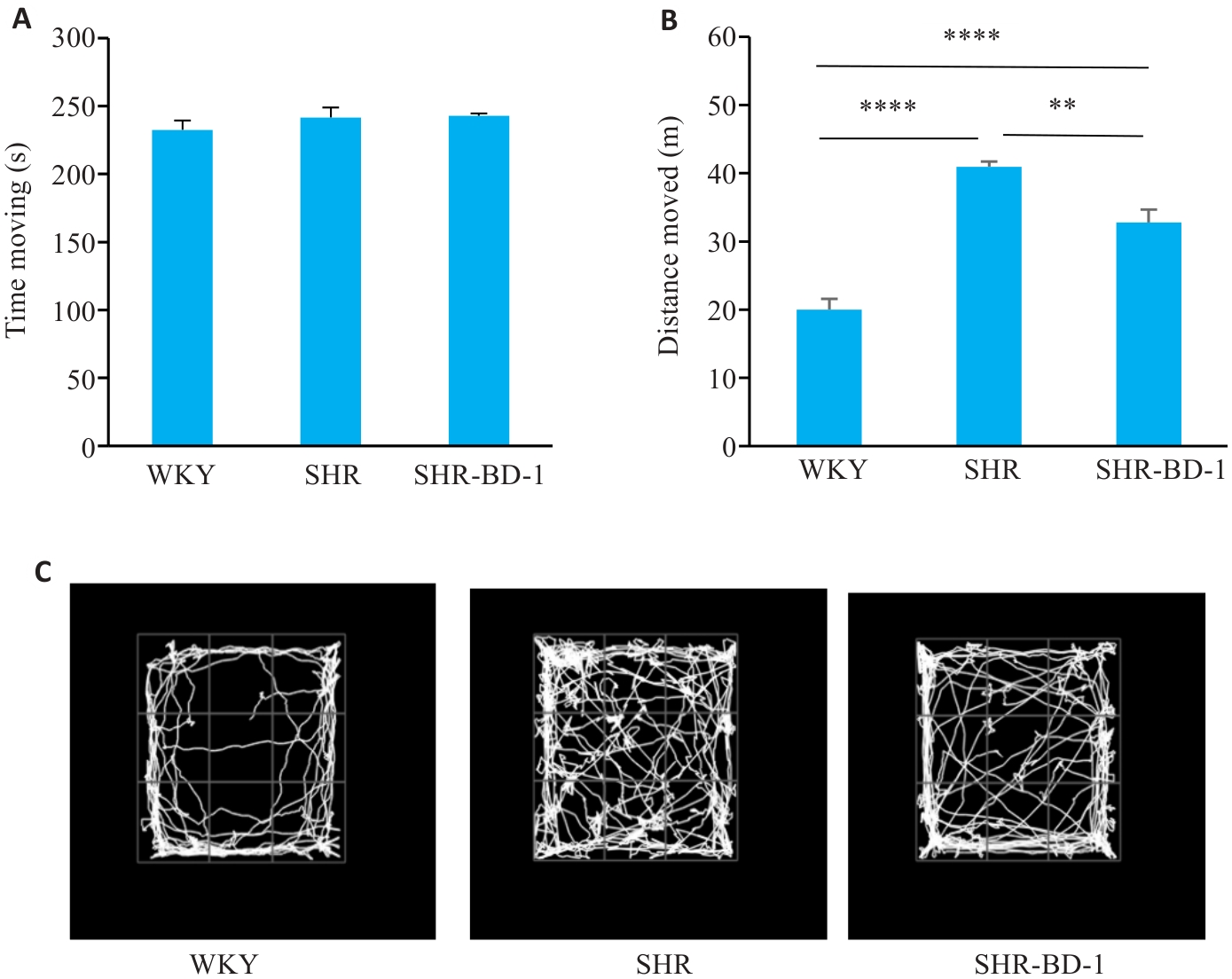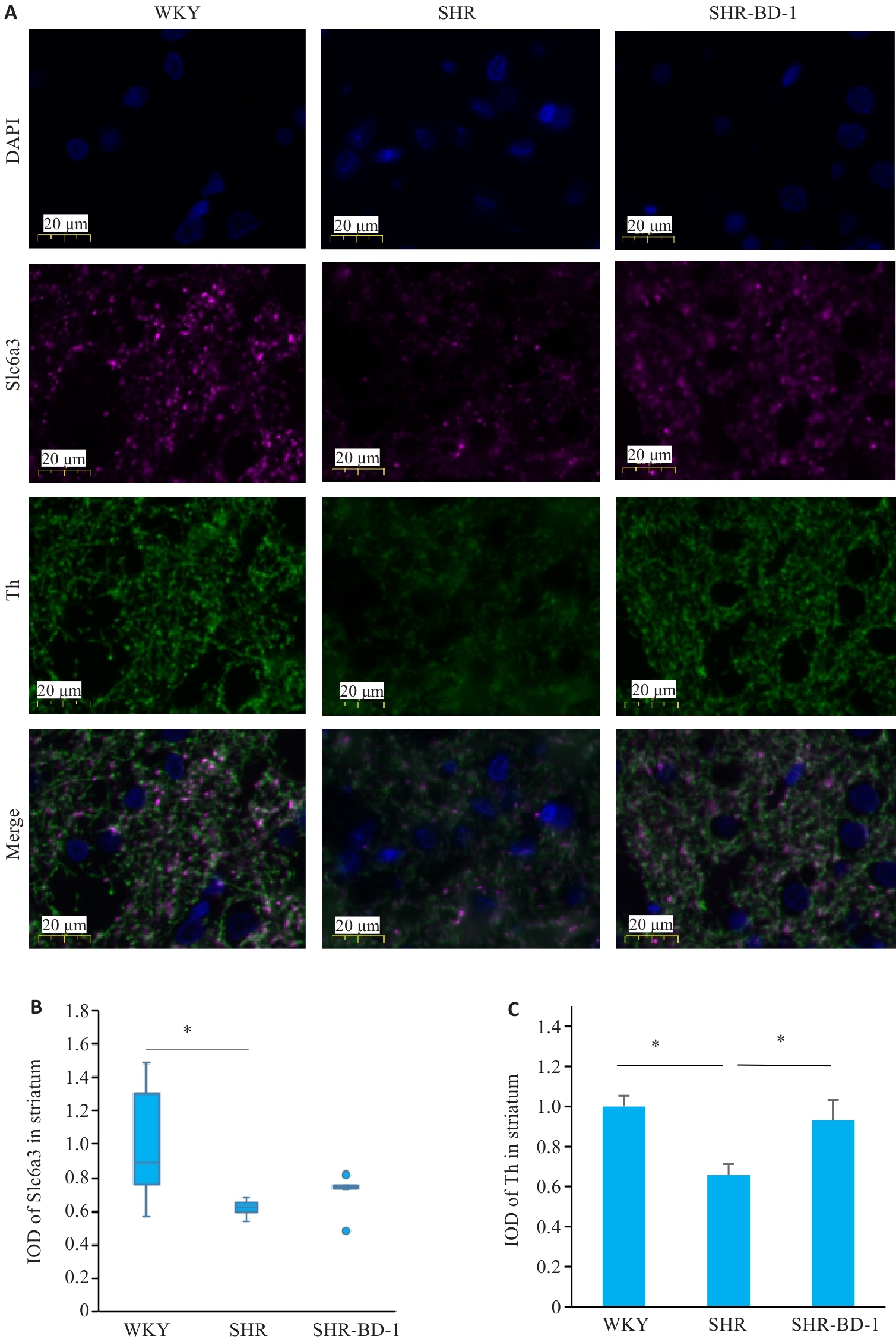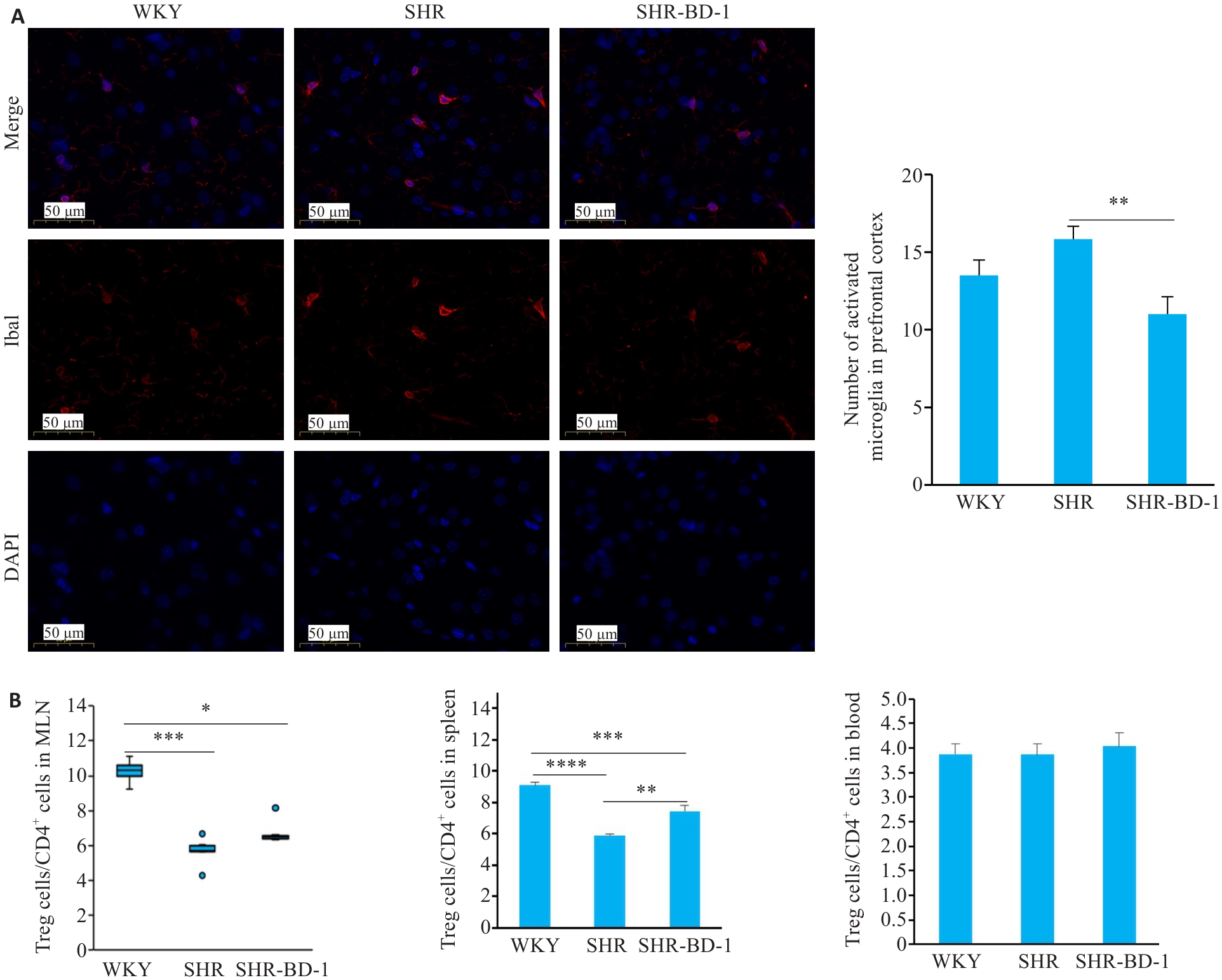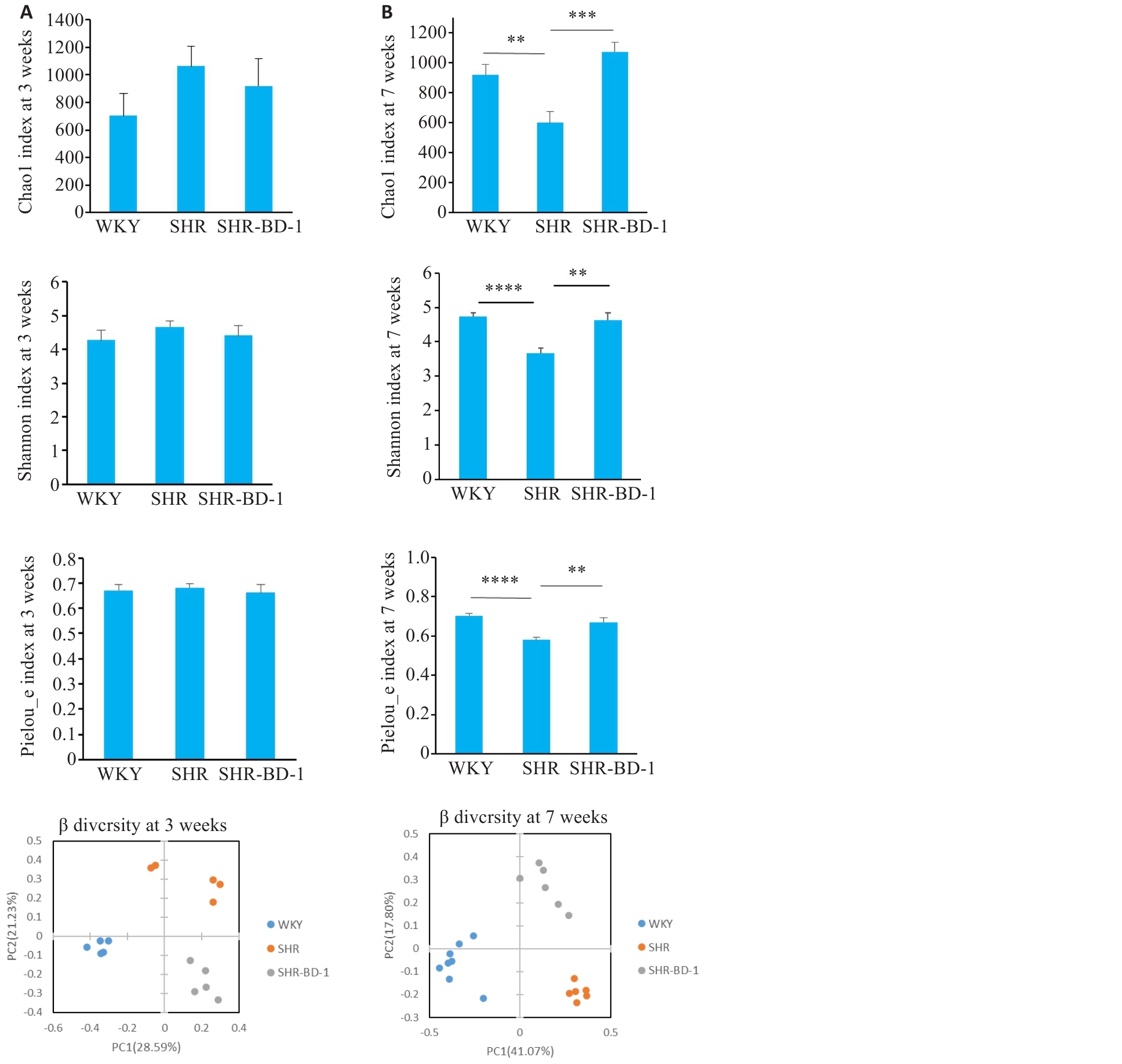Journal of Southern Medical University ›› 2025, Vol. 45 ›› Issue (4): 702-710.doi: 10.12122/j.issn.1673-4254.2025.04.04
Previous Articles Next Articles
Yang YANG( ), Kai WANG, Jianxiu LIU, Zhimo ZHOU, Wen JIA, Simou WU, Jinxing LI, Fang HE, Ruyue CHENG(
), Kai WANG, Jianxiu LIU, Zhimo ZHOU, Wen JIA, Simou WU, Jinxing LI, Fang HE, Ruyue CHENG( )
)
Received:2024-10-15
Online:2025-04-20
Published:2025-04-28
Contact:
Ruyue CHENG
E-mail:yywishesyouhappiness@alu.scu.edu.cn;ruyuecheng1993@163.com
Supported by:Yang YANG, Kai WANG, Jianxiu LIU, Zhimo ZHOU, Wen JIA, Simou WU, Jinxing LI, Fang HE, Ruyue CHENG. Early life Bifidobacterium bifidum BD-1 intervention alleviates hyperactivity of juvenile female rats with attention deficit hyperactivity disorder[J]. Journal of Southern Medical University, 2025, 45(4): 702-710.
Add to citation manager EndNote|Ris|BibTeX
URL: https://www.j-smu.com/EN/10.12122/j.issn.1673-4254.2025.04.04

Fig.1 Effects of BD-1 intervention on hyperactivity in SHRs. A: Time moving in the OFT.B: Distance moved in the OFT. C: Representative trace maps of the rats. (n=8 in WKY group, n=6 in SHR group, n=6 in SHR-BD-1 group). **P<0.01, ****P<0.0001.

Fig.2 Effects of BD-1 intervention on expressions of DAT and Th in the striatum of the rats. A: Immunofluorescence staining of the striatum. B: IOD of DAT in the striatum. C: IOD of Th in the striatum. *P<0.05.

Fig.3 Effects of BD-1 intervention on the number of activated microglia in the prefrontal cortex and Treg cells in the mesenteric lymph nodes (MLN), spleen and blood of the rats. A: Immunofluorescence staining and calculation of activated microglia in the prefrontal cortex. B: Number of Treg cells/CD4+ cells (%) in the MLN, spleen and blood (n=8 in WKY group, n=6 in SHR group, n=6 in SHR-BD-1 group). *P<0.05, **P<0.01, ***P<0.001, ****P<0.0001.

Fig.4 Effects of BD-1 intervention on gut microbiota diversity in the rats. A: α diversity and principal coordinate analysis map of β diversity of gut microbiota at 3 weeks (n=5). B: α diversity and principal coordinate analysis map of β diversity of the gut microbiota at 7 weeks (n=8 in WKY group, n=6 in SHR group, n=6 in SHR-BD-1 group). **P<0.01, ***P<0.001, ****P<0.0001.
| 1 | 李 希, 陈向坚, 陈竞建, 等. 注意缺陷多动障碍儿童肠道菌群特点及与行为问题的相关性研究[J]. 中国微生态学杂志, 2024, 36(3): 313-6. |
| 2 | 张雪宁, 谢振中, 庞玉兰. 注意缺陷多动障碍患儿肠道细菌构成特点及临床意义[J]. 中国妇幼保健, 2023, 38(14): 2593-6. |
| 3 | Ahrens AP, Hyötyläinen T, Petrone JR, et al. Infant microbes and metabolites point to childhood neurodevelopmental disorders[J]. Cell, 2024, 187(8): 1853-73.e15. |
| 4 | Pärtty A, Kalliomäki M, Wacklin P, et al. A possible link between early probiotic intervention and the risk of neuropsychiatric disorders later in childhood: a randomized trial[J]. Pediatr Res, 2015, 77(6): 823-8. |
| 5 | Hashemi A, Villa CR, Comelli EM. Probiotics in early life: a preventative and treatment approach[J]. Food Funct, 2016, 7(4): 1752-68. |
| 6 | Sagvolden T, Metzger MA, Schiørbeck HK, et al. The spontaneously hypertensive rat (SHR) as an animal model of childhood hyperactivity (ADHD): changed reactivity to reinforcers and to psychomotor stimulants[J]. Behav Neural Biol, 1992, 58(2): 103-12. |
| 7 | David Jentsch J. Impaired visuospatial divided attention in the spontaneously hypertensive rat[J]. Behav Brain Res, 2005, 157(2): 323-30. |
| 8 | Fang ZL, Shen GH, Amin N, et al. Effects of neuroinflammation and autophagy on the structure of the blood-brain barrier in ADHD model[J]. Neuroscience, 2023, 530: 17-25. |
| 9 | Dunn GA, Nigg JT, Sullivan EL. Neuroinflammation as a risk factor for attention deficit hyperactivity disorder[J]. Pharmacol Biochem Behav, 2019, 182: 22-34. |
| 10 | Yin XD, Liu WC, Feng HH, et al. Bifidobacterium animalis subsp. lactis A6 attenuates hippocampal damage and memory impairments in an ADHD rat model[J]. Food Funct, 2024, 15(5): 2668-78. |
| 11 | Raony Í, Domith I, Lourenco MV, et al. Trace amine-associated receptor 1 modulates motor hyperactivity, cognition, and anxiety-like behavior in an animal model of ADHD[J]. Prog Neuropsychopharmacol Biol Psychiatry, 2022, 117: 110555. |
| 12 | Ramtekkar UP, Reiersen AM, Todorov AA, et al. Sex and age differences in attention-deficit/hyperactivity disorder symptoms and diagnoses: implications for DSM-V and ICD-11[J]. J Am Acad Child Adolesc Psychiatry, 2010, 49(3): 217-28.e1-3. |
| 13 | Hasson R, Fine JG. Gender differences among children with ADHD on continuous performance tests: a meta-analytic review[J]. J Atten Disord, 2012, 16(3): 190-8. |
| 14 | Shobeiri P, Kalantari A, Teixeira AL, et al. Shedding light on biological sex differences and microbiota-gut-brain axis: a comprehensive review of its roles in neuropsychiatric disorders[J]. Biol Sex Differ, 2022, 13(1): 12. |
| 15 | Peng CR, Li JX, Miao ZH, et al. Early life administration of Bifidobacterium bifidum BD-1 alleviates long-term colitis by remodeling the gut microbiota and promoting intestinal barrier development[J]. Front Microbiol, 2022, 13: 916824. |
| 16 | 许晓林, 王斯栌, 陈 菲, 等. 利用2’-岩藻糖基乳糖生长的两歧双歧杆菌BD-1免疫调节功能评价[J]. 中国微生态学杂志, 2024, 36(7): 745-52, 760. |
| 17 | Rucklidge JJ. Gender differences in attention-deficit/hyperactivity disorder[J]. Psychiatr Clin North Am, 2010, 33(2): 357-73. |
| 18 | Prehn-Kristensen A, Zimmermann A, Tittmann L, et al. Reduced microbiome alpha diversity in young patients with ADHD[J]. PLoS One, 2018, 13(7): e0200728. |
| 19 | Wang N, Wang HB, Bai Y, et al. Metagenomic analysis reveals difference of gut microbiota in ADHD[J]. J Atten Disord, 2024, 28(5): 872-9. |
| 20 | Stojanov S, Berlec A, Štrukelj B. The influence of probiotics on the firmicutes/bacteroidetes ratio in the treatment of obesity and inflammatory bowel disease[J]. Microorganisms, 2020, 8(11): 1715. |
| 21 | 张 珊, 万 林, 孙于林, 等. 注意缺陷多动障碍患儿的肠道菌群特征[J]. 临床儿科杂志, 2020, 38(4): 264-8. |
| 22 | Zhu YQ, Chen BR, Zhang XY, et al. Exploration of the Muribaculaceae family in the gut microbiota: diversity, metabolism, and function[J]. Nutrients, 2024, 16(16): 2660. |
| 23 | Mann ER, Lam YK, Uhlig HH. Short-chain fatty acids: linking diet, the microbiome and immunity[J]. Nat Rev Immunol, 2024, 24(8): 577-95. |
| 24 | Koontanatechanon A, Wongphatcharachai M, Nonthabenjawan N, et al. The effects of increasing dietary fat on serum lipid profile and modification of gut microbiome in C57BL/6N mice[J]. J Oleo Sci, 2022, 71(7): 1039-49. |
| 25 | Mittleman BB, Castellanos FX, Jacobsen LK, et al. Cerebrospinal fluid cytokines in pediatric neuropsychiatric disease[J]. J Immunol, 1997, 159(6): 2994-9. |
| 26 | Donfrancesco R, Nativio P, Di Benedetto A, et al. Anti-yo antibodies in children with ADHD: first results about serum cytokines[J]. J Atten Disord, 2020, 24(11): 1497-502. |
| 27 | Elsadek AE, Al-Shokary AH, Abdelghani WE, et al. Serum levels of interleukin-6 and tumor necrosis factor alpha in children with attention-deficit hyperactivity disorder[J]. J Pediatr Neurosci, 2020, 15(4): 402-8. |
| 28 | Barbi J, Pardoll D, Pan F. Treg functional stability and its responsiveness to the microenvironment[J]. Immunol Rev, 2014, 259(1): 115-39. |
| 29 | Gao X, Tang YR, Kong LL, et al. Treg cell: Critical role of regulatory T-cells in depression[J]. Pharmacol Res, 2023, 195: 106893. |
| 30 | Kessi M, Duan H, Xiong J, et al. Attention-deficit/hyperactive disorder updates[J]. Front Mol Neurosci, 2022, 15: 925049. |
| 31 | Kurzina NP, Volnova AB, Aristova IY, et al. A new paradigm for training hyperactive dopamine transporter knockout rats: influence of novel stimuli on object recognition[J]. Front Behav Neurosci, 2021, 15: 654469. |
| 32 | Colette Daubner S, Le T, Wang SZ. Tyrosine hydroxylase and regulation of dopamine synthesis[J]. Arch Biochem Biophys, 2011, 508(1): 1-12. |
| 33 | Leo D, Sorrentino E, Volpicelli F, et al. Altered midbrain dopaminergic neurotransmission during development in an animal model of ADHD[J]. Neurosci Biobehav Rev, 2003, 27(7): 661-9. |
| 34 | Singh S, Mishra A, Srivastava N, et al. Acetyl-L-carnitine via upegulating dopamine D1 receptor and attenuating microglial activation prevents neuronal loss and improves memory functions in parkinsonian rats[J]. Mol Neurobiol, 2018, 55(1): 583-602. |
| [1] | Linyu XIAO, Ting DUAN, Yongsheng XIA, Yue CHEN, Yang SUN, Yibo XU, Lei XU, Xingzhou YAN, Jianguo HU. Linarin inhibits microglia activation-mediated neuroinflammation and neuronal apoptosis in mouse spinal cord injury by inhibiting the TLR4/NF-κB pathway [J]. Journal of Southern Medical University, 2024, 44(8): 1589-1598. |
| [2] | GUI Jianjun, SUN Xiaodong, WEN Shu, LIU Xin, QIN Bingqing, SANG Ming. Resveratrol protects dopaminergic neurons in a mouse model of Parkinson's disease by regulating the gut-brain axis via inhibiting the TLR4 signaling pathway [J]. Journal of Southern Medical University, 2024, 44(2): 270-279. |
| [3] | Chengcheng JIANG, Yangyang LI, Kexin DUAN, Tingting ZHAN, Zilong CHEN, Yongxue WANG, Rui ZHAO, Caiyun MA, Yu GUO, Changqing LIU. Parkin deletion affects PINK1/Parkin-mediated mitochondrial autophagy to exacerbate neuroinflammation and accelerate progression of Parkinson's disease in mice [J]. Journal of Southern Medical University, 2024, 44(12): 2359-2366. |
| [4] | ZHANG Meng, ZHANG Yuanyuan, NIU Mengzhu, ZHU Yue, TONG Shiyi, KOU Xianjuan. Dihydromyricetin alleviates pyroptosis and necroptosis in mice with MPTP-induced chronic Parkinson's disease by inducing autophagy [J]. Journal of Southern Medical University, 2023, 43(8): 1268-1278. |
| [5] | ZHANG Jiafa, YANG Canhong, ZHANG Shufen, CAO Tingting, PENG Rui, GUO Weihong, YAN Yuping, XIE Shuting, PENG Xiaojia, LÜ Tianming, HUANG Tianrong. Sulforaphane reverses Aβ fiber-mediated M1 type microglia polarization and neuroinflammation-mediated necroptosis of neural stem cells by downregulating the MAPK/NF-κB signaling pathways [J]. Journal of Southern Medical University, 2023, 43(12): 2132-2138. |
| [6] | . Macrophage migration inhibitory factor meditates MPP+/MPTP-induced NLRP3 inflammasome activation in microglia cells [J]. Journal of Southern Medical University, 2021, 41(7): 972-979. |
| [7] | . Choline improves lipopolysaccharide-induced central nervous system inflammatory response and cognitive dysfunction in mice [J]. Journal of Southern Medical University, 2017, 37(05): 600-. |
| Viewed | ||||||
|
Full text |
|
|||||
|
Abstract |
|
|||||